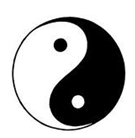Written by Shifu Raymond Ahles
The concept of yin & yang dates back more than 5000 years in China. It is a way in which all existence is explained and yet it does not conflict with any modern day thinking, including science and religion.
Without going into any depth of explaining why it does not conflict, I would rather just discuss the concept briefly and leave the rest up to you. Hopefully, after seeing its simplicity, you will see that it is only a way to describe parts of a whole. There is no yang without yin, just as there is no north without south.
If yang is light, yin is heavy; if yang is active, yin is inactive; if yang is the sky, yin is the ground; if yang is male, yin is female; if yang is day, yin is night; if yang is hot, yin is cold; if yang is bright, yin is dull; if yang is hard, yin is soft.
Anything can be analyzed in terms of yin & yang. When punching, the extending hand can be considered yang (expressed), with the fist pulling to the waist considered yin (root); in an “empty stance”, the weighted leg can be yin (full and rooted), while the empty leg can be yang (light and prepared to kick). You must have both or you have nothing!
Yin & yang can change according to perception in many cases: in moving ch’i kung, while attention is on the weight shifting from one leg to the other, the more weighted leg can be considered yang while the body is moving towards it (active, attention is there), and the other leg is yin (passive, less attention).
Yin & yang also control or balance each other. For example, when the temperature of something is neither hot nor cold, it is because each aspect is held in check by the other. In other words, if something is cold, it is because there is not enough heat, or vice versa (make sense?).
The extreme of one, becomes the other. Day turns into night, just as night turns into day; an inhale must eventually become an exhale, and any activity must eventually be followed by rest. Get the picture?
So what is the significance of all this? Well, for one interesting example, this 5000+ year old concept has brought us the modern computer age. It is the most fundamental part of today’s digital computer architecture! All computer technology is based on the binary system of “1″ and “0″. This is how a computer communicates within itself. The two are then grouped into eight (8 bits), and all forms of memory and information are just multiples of this (today’s Pentium is based on 32bit architecture for example!).*
It is interesting to mention here that “The Book of Changes”, or “I Ching” (pronounced “ee ching”), which dates back nearly 5000 years, (this is where the eight trigrams, the groups of three lines around the yin & yang symbol used in our logo, originated), is also based on yin & yang, and uses multiples of eight to explain how everything in the universe is in a constant state of change.
*Special thanks to Kevin Crawford for his computer savvy for this article!
